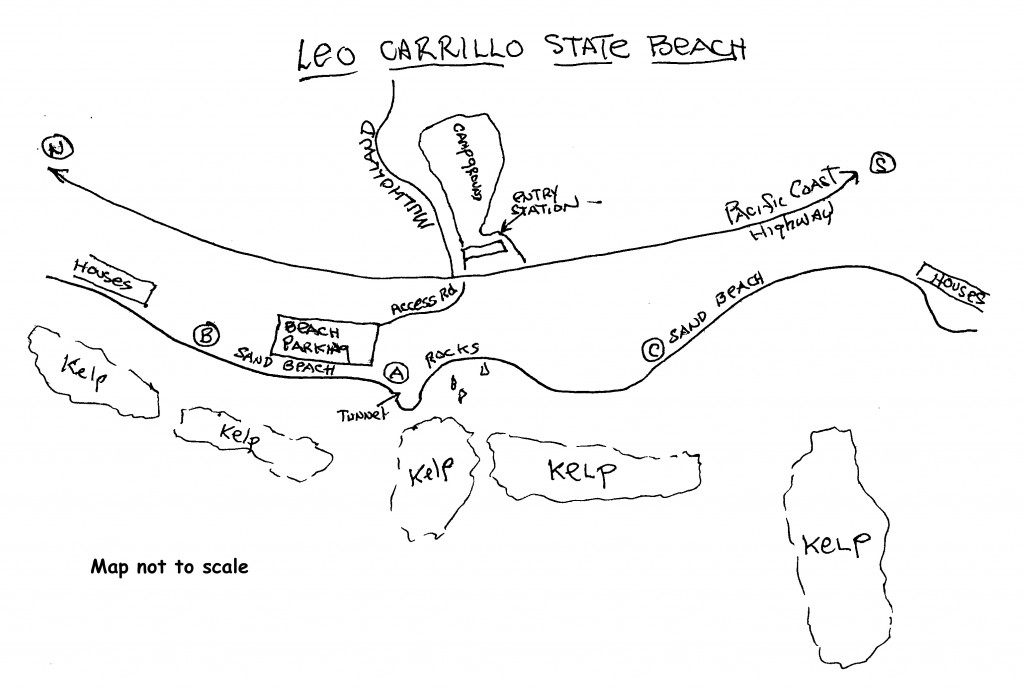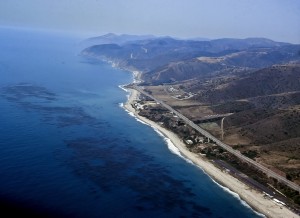Leo Carrillo State Beach Park Ever since I was young I’ve always liked to camp out, and after I started diving I continued to keep up with that tradition. Leo Carrillo State Park has always been one of my favorite destinations. Conveniently, you can make reservations in advance on the internet to insure a space. The campground has beach access, features great camp sites, hot showers to enjoy after the dive, and it’s also close to restaurants and a market in Malibu. On top of that, it’s located adjacent to some great beach diving sites. An easy drive from the greater Los Angeles area and Orange County to the south, or the Oxnard-Ventura area to the north, it’s located off the Pacific Coast Highway between Malibu and Port Hueneme.
We’ve already featured diving logs for nearby Zuma Beach (Pismo clams and halibut), and Malibu Road (lobsters, halibut, and bass). There’s also great diving even closer. You can dive in front of the campground, make a short drive north to County Line beach, or head up a little further north to another state campground and beach access at Sycamore Canyon Beach.
 The entry near the north end of the Leo Carrillo beach parking lot, marked ‘B’ on the chart, is over fairly steep shelving sand that makes it easy to get downhill into the water but harder to exit uphill. Still, unless there’s a large swell, it’s reasonably easy. The dive is outside and to the north through rocks under the kelp that harbors small scallops, bass, rockfish, and an occasional lobster or halibut. It’s been picked over because it’s near the campground, but it still makes for a pretty dive.
The entry near the north end of the Leo Carrillo beach parking lot, marked ‘B’ on the chart, is over fairly steep shelving sand that makes it easy to get downhill into the water but harder to exit uphill. Still, unless there’s a large swell, it’s reasonably easy. The dive is outside and to the north through rocks under the kelp that harbors small scallops, bass, rockfish, and an occasional lobster or halibut. It’s been picked over because it’s near the campground, but it still makes for a pretty dive.
The entry near the south end of the beach parking lot, marked ‘A’ on the chart, is similar. The kelp bed off the point there is smaller, but it features similar structure and animals. I’ve had good luck with halibut here diving along the inside edge of the kelp when visibility is acceptable. There’s a small tunnel in the surf line here that goes through the end of the point. Kids gravitate to play here, and you’ll often find TV crews filming commercials along the north edge of this point. Later, when you see those commercials on the tube it’ll add to the ambience of your stay.
The south beach entry, marked ‘C’ on your chart, is also over sand, but it’s more gradual and less slopping. The southern kelp bed extends much further out to sea here, and in years past we used to find red abalone along with the rest of the fishy denizens previously mentioned. This patch of kelp is usually the best local area if you are hunting lobsters. The large gravel-sand areas between the two kelp beds usually hold fair numbers of halibut in summer months, too.
One of the best things about camping here is that everything is family friendly. You don’t have to be a diver to enjoy this place, so you can bring the non-diving neighbors and relatives along to enjoy an evening fire for story telling after the dive. I used to love collecting a potpourri of eatable sea life, and making a seafood chowder or fish stew for everyone to enjoy after the dive. Try a weekend here sometime, if you like to camp and dive as I do, a good time will be had by all.
Next week we’ll talk about Sycamore Canyon, just up the coast from Leo Carrillo.

